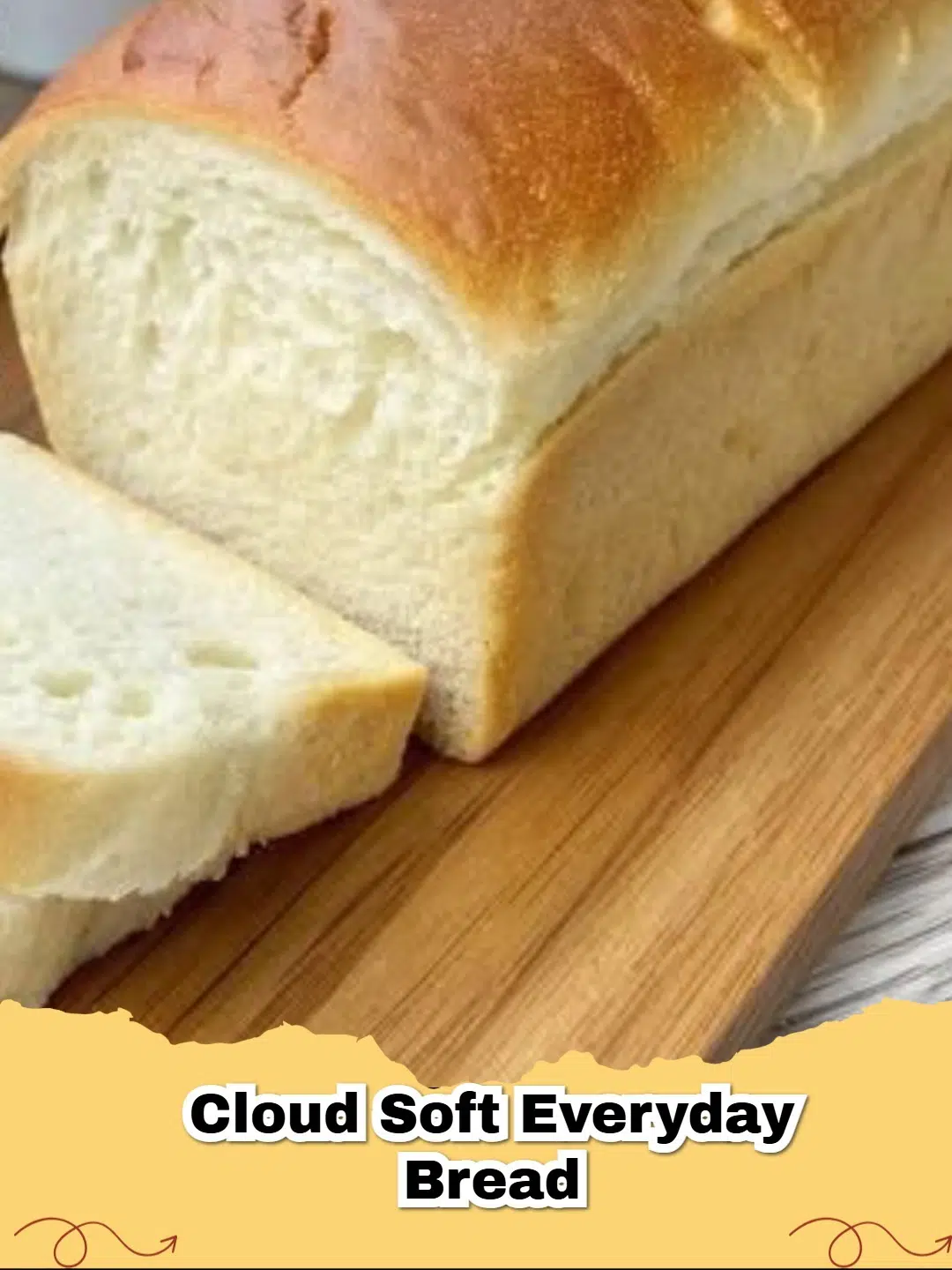There’s a unique joy that comes from baking bread at home, and the aroma alone is enough to bring warmth and comfort to any kitchen. This Cloud Soft Everyday Bread recipe is designed to bring that simple pleasure into your life with a loaf so tender, so airy, you’ll wonder why you ever settled for store-bought.
Why This Homemade Loaf Will Become Your Favorite
Our Cloud Soft Everyday Bread lives up to its name. It’s light, fluffy, and boasts a delicate crust that makes it perfect for everything from slicing for sandwiches to toasting with your morning coffee. This recipe is straightforward, making it approachable for both seasoned bakers and those new to the art of bread-making. Plus, knowing exactly what goes into your bread offers an incredible sense of satisfaction.
The Simple Ingredients Behind Extraordinary Softness
Achieving a truly cloud-soft loaf relies on a few key ingredients, each playing a vital role:
- Active Dry Yeast: This is our rising agent, creating that beautiful airy texture. Make sure your yeast is fresh and active for the best results. You can learn more about how to test your yeast's activity.
- All-Purpose Flour: The foundation of our bread, providing the perfect gluten structure without making the loaf too dense.
- Milk and Water: A harmonious blend that adds richness and moisture, contributing significantly to the bread's tender crumb.
- Granulated Sugar: Feeds the yeast, helping it activate, and adds a subtle hint of sweetness to the finished loaf.
- Salt: Crucial for enhancing flavor and regulating yeast activity.
- Unsalted Butter: Softened butter enriches the dough, making it incredibly tender and flavorful.
Step-by-Step Guide to Your Cloud Soft Loaf
Baking bread is a rewarding process, and following these steps will ensure a perfect loaf every time.
Proofing Your Yeast
Start by proofing your yeast. This confirms it’s active and ready to make your bread rise beautifully. Combine warm milk and water with sugar, then sprinkle the yeast over it. Let it sit for 5-10 minutes until it becomes frothy. This bubbling action is a good sign your yeast is alive and well!
Kneading for Perfection
Kneading is where the magic happens, developing the gluten that gives bread its structure. Whether by hand or with a stand mixer, aim for 8-10 minutes of kneading until the dough is smooth, elastic, and no longer sticky. A good test is the 'windowpane test': if you can stretch a small piece of dough thin enough to see light through it without tearing, you've kneaded enough.
The Importance of Proofing (Rising)
Patience is a virtue in bread making. Allow your dough to rise in a warm, draft-free spot until it doubles in size for both the first and second proofs. This could take anywhere from 1 to 2 hours, depending on your kitchen's temperature. Under-proofed dough leads to dense bread, while over-proofed dough can collapse.
Serving Suggestions and Storage
Once your Cloud Soft Everyday Bread emerges golden from the oven and has cooled, prepare for an amazing treat! It’s incredible toasted with butter and jam, forms the ideal foundation for classic sandwiches, or can be served alongside a comforting dish like Slow Cooker Beef Curry. For breakfast, consider a slice with a smear of cream cheese and a side of Heavenly Honeycrisp Apple Cake. To maintain its softness, store completely cooled bread in an airtight container or bread bag at room temperature for up to 3-4 days. For longer storage, slice and freeze, then toast as needed.
Embrace the warmth, flavor, and incredible texture of homemade bread. Your kitchen (and your taste buds) will thank you!
FAQs
What makes this everyday bread so 'cloud soft'?
The secret to its cloud-like softness lies in using a blend of warm milk and water, along with butter, which enriches the dough. Careful kneading and proper proofing also contribute significantly to its tender, airy texture.
Can I make this bread in a stand mixer?
Absolutely! A stand mixer with a dough hook makes the kneading process much easier. Just ensure you knead for the recommended 8-10 minutes until the dough is smooth and elastic.
How should I store leftover Cloud Soft Everyday Bread?
Once completely cooled, store your bread in an airtight container or a bread bag at room temperature. It will stay fresh for 3-4 days. Avoid refrigerating, as it can dry out the bread quickly.
Can I freeze this homemade bread?
Yes! This bread freezes beautifully. Once cooled, slice the loaf and place the slices in a freezer-safe bag or wrap them tightly. It can be frozen for up to 3 months. Toast slices directly from frozen for quick enjoyment.

Cloud Soft Everyday Bread
- Total Time: 2 hours 30 minutes (includes rise time)
- Yield: 1 loaf (12-16 slices) 1x
- Diet: Vegetarian
Description
An incredibly soft and airy homemade bread, perfect for daily use, sandwiches, toast, or alongside any meal.
Ingredients
1 cup warm milk (105-115°F)
1/2 cup warm water (105-115°F)
2 tablespoons granulated sugar
2 1/4 teaspoons active dry yeast (one packet)
4-4 1/2 cups all-purpose flour, plus more for dusting
1 1/2 teaspoons salt
4 tablespoons unsalted butter, softened
Instructions
Step 1: In a large bowl or the bowl of a stand mixer, combine warm milk, warm water, and granulated sugar. Sprinkle the active dry yeast over the liquid and let it sit for 5-10 minutes, until frothy. If it doesn't foam, your yeast may be old; start over with new yeast.
Step 2: Add 4 cups of the all-purpose flour and salt to the yeast mixture. Mix with a spoon or dough hook until a shaggy dough forms. Add the softened butter and continue to mix.
Step 3: Knead the dough for 8-10 minutes using a stand mixer with a dough hook on medium-low speed, or by hand on a lightly floured surface, until the dough is smooth, elastic, and passes the windowpane test (you can stretch a small piece thin enough to see light through it without tearing). Add more flour, a tablespoon at a time, if the dough is too sticky.
Step 4: Lightly grease a clean large bowl with oil. Place the dough in the bowl, turning once to coat. Cover the bowl with plastic wrap or a clean kitchen towel and let it rise in a warm, draft-free place for 1-1.5 hours, or until doubled in size.
Step 5: Gently punch down the risen dough to release the air. Transfer it to a lightly floured surface and shape it into a log. Place the dough log seam-side down into a lightly greased 9x5 inch loaf pan.
Step 6: Cover the loaf pan with plastic wrap or a kitchen towel and let it rise again in a warm, draft-free place for another 30-45 minutes, or until nearly doubled in size.
Step 7: Preheat your oven to 375°F (190°C) during the last 15 minutes of the second rise. Bake the bread for 30-35 minutes, or until the top is golden brown and the internal temperature reaches 200-210°F (93-99°C).
Step 8: Remove the loaf from the oven and immediately transfer it to a wire rack to cool completely before slicing. This prevents the bread from becoming gummy.
Notes
For an extra soft crust, brush the top of the hot loaf with a little melted butter immediately after removing it from the oven. Ensure all your ingredients are at room temperature for best results.
- Prep Time: 20 minutes
- Cook Time: 30-35 minutes
- Category: Bread
- Method: Baking
- Cuisine: American
Nutrition
- Serving Size: 1 slice
- Calories: 180 kcal
- Sugar: 3g
- Sodium: 280mg
- Fat: 3g
- Saturated Fat: 2g
- Unsaturated Fat: 1g
- Trans Fat: 0g
- Carbohydrates: 32g
- Fiber: 1g
- Protein: 6g
- Cholesterol: 10mg










Leave a Reply